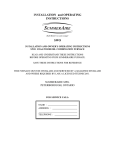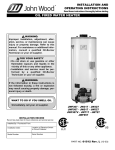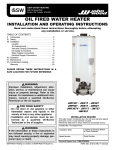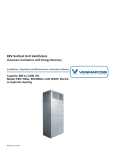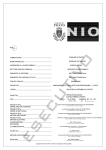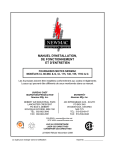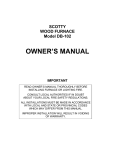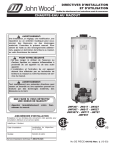Download SBB - English Manual - Heat Recovery Ventilators, Air Handlers
Transcript
INSTALLATION and OPERATING INSTRUCTIONS SUMMERAIRE GAMME SMO SBB INSTALLATION AND OWNER’S OPERATING INSTRUCTIONS SBB WOOD/OIL COMBINATION FURNACE READ AND UNDERSTAND THESE INSTRUCTIONS BEFORE OPERATING YOUR SUMMERAIRE FURNACE. SAVE THESE INSTRUCTIONS FOR REFERENCE THIS FURNACE MUST BE INSTALLED AND SERVICED BY A QUALIFIED INSTALLER AND WHERE REQUIRED BY LAW, A LICENCED TECHNICIAN. SUMMERAIRE MFG. PETERBOROUGH, ONTARIO FOR SERVICE CALL: NAME : __________________________ ADDRESS : ______________________ __________________________________ TELEPHONE : ____________________ Installation Instructions In all cases, local building codes should be observed. Furnace Is Shipped In Six Packages: Duct Connection 1. Furnace heat exchanger, complete with fire door. The return air duct connection should be tight, so that the blower cannot draw air from he furnace room which can interfere with the combustion air supply. A plenum chamber or an elbow type connection may be used. Sufficient air flow must be provided for efficient operation. An opening into the furnace room should be made to the outdoors if there is not sufficient air infiltration. The equipment has to be installed in accordance with the standards of the National Board of Fire Fire Underwriters. Authorities who have jurisdiction should be consulted before installations are made. 2. Blower section (can be mounted left or right hand) complete with blower, miscellaneous parts bag, filters. 3. Burner with flame retention head and oil combustion safety control; Field wiring junction box with transformer, solid fuel relay, blower wiring harness, burner cable and fan limit control with support; Belt and pulleys; Solid fuel damper motor; Thermostats for solid fuel and oil; Smoke baffle tool; Blower motor; Draft regulator; 4,5, & 6 Three cartons containing a total of 30 firebricks. Installation Of The Combination Furnace Chimney and Flue Pipe Clearance to Combustibles Top plenum Front Side Wood One Side Oil Burner rear side Flue Pipe Other Side Base or Floor non-combustible Duct work may be reduced to 2” at 72” from plenum MBFU Standards Include: Standards for the installation of oil burning equipment. NBFU No. 31. Standards for the installation of air conditioning, warm air heating and ventilating system. NBFU No. 90. Building code standards for the installation of heat-producing appliances, heating, ventilating, air conditioning, blower and exhaust systems. 6” 48” 6” 24” 18” 24” Caution: Flue Pipe to Controls - 12” Location Refer to C.S.A. B139 “CODE FOR INSTALLATION OF OIL BURNER EQUIPMENT” for recommended installation practices. Consider the following before placing the furnace; The furnace should be centrally located in relation to the outlet registers, with large warm air ducts, for improved heat distribution during electrical power failures, when the furnace has to work on the gravity principle. The flue connection to the chimney should be short and direct and consist of as few elbows as possible. Sufficient space must be provided for access to the burner, the controls, and along one side and at the rear of the unit to provide access to the filters and blower. See above for required clearances. To ensure an easy installation of the two part furnace, prepare a cement pad size 50” X 45” at least 2” thick, as level as possible. It makes alignment of the two parts easier. The chimney should be thoroughly inspected and cleaned to ensure safe furnace operation. It is very important that the chimney has an adequate capacity and develops a good draft for proper combustion. .03 to .05 inches WC at the flue connection of the furnace, and .01 to .03 inches draft over the fire. Maximum chimney draft should never exceed - 0.03” WC since a power failure could cause wood fire to burn out of control. Minimum inside chimney 64 sq. inches. The flue pipe must be full size and not lighter than No. 24 gauge black iron pipe. The flue pipe connection should be short and direct with as few elbows as possible and should slope up toward chimney. Make certain the flue pipe or thimble does not project into the chimney flue. All sections of the flue pipe should be fastened with sheet metal screws. Under no circumstances should the flue pipe contain a hand-operated damper. Warning: Do not mount flue pipe close to or in front of limit and operating controls. Draft Regulator: The draft regulator may be located on either the vertical or horizontal section of the flue pipe. The best location is 18” from the furnace flue outlet. The regulator must be level (without leaning forward or backward) and the pivoting axis has to be horizontal. Follow instructions for installation which is supplied with the Draft Regulator. Thermostats: How To Install Fire Brick: Drawing #2 Select a location which is representative of the average house temperature, usually the living room. The thermostats should be mounted on an inside wall, never where they will be subjected to drafts (warm or cold), above a radio or television set, or where the sun’s rays or heat from registers will affect them. See instructions supplied with the thermostats. 1. Install 6 brick in floor of firebox (see layout) 2. Place bottom row of bricks (for fire box sides, front and back), making sure bricks are in brick plate support frame which is an integral part of the box. 3. Repeat second and third rows of brick. 4. Install stainless steel front brick guard using bolts provided. 5. Install “U” shaped top brick guard, inserting open ends of guard into loops provided on inside of door opening. For masonary chimneys refer to C.S.A. B1398 (p. 83). For All Fuel chimneys consult manufacturers’ tables. Furnace Assembly: Drawing #4 Locate Heat Exchanger Section in desired area Four location points for locating blower port are supplied on left and right side of furnace section, burner end. Cut desired side for blower to enter furnace section. Place blower section against furnace section and attach with screws. Furnace must be assembled as per drawing and fan-limit control location identical to drawing, casing screw holes are provided for exact locations. See Drawing No. 1. Note: Due to the taper design of firebox mortar is not required. Installation Tips *Minimum Duct sizes Model SBB Supply Air 8 X 24 Return Air 8 X 24 * The supply air extended plenum size should be the same as “Minimum Square inches” shown in above table for 8-10 feet from furnace, then gradually reduced to the end of the duct system. * Use a minimum pipe size of 6 inches in diameter in runs and in no case smaller than 5 inches in diameter. Wire according to wiring diagram. How To Mount The Burner: * Set blower C.F.M. to obtain 85°F temperature rise through unit, when fired on oil. The burner is flush mounted with three positioning bolts on the front plate. Connect the burner conduit cable provided on the wiring harness - follow wiring diagram. Check nozzle size, tightness and chamber alignment. Set up burner to #1 Smoke. Finally Wiring The Furnace: Drawing #3 2. That installation is made in accordance with C.S.A. Installation Standard B 139 or the National Building Code or NBFU No. 31 Each furnace is supplied with the necessary wiring harness. Follow diagrams for wiring and correct location of the controls included in these instructions. All electrical equipment and wiring has to installed following the requirements of the Canadian or U.S. electrical code as well as regulations of local authorities. Solid Fuel Damper Control: Drawing #1 The thermostat for the solid fuel section activates the damper control - which in turn moves the damper flap. It is essential that the damper control is at all time in perfect working order. Note: Adjust damper chain so that damper flap opens no more than 1/2”. When oil is used as fuel close all combustion air inlets to solid fuel side of furnace. Excessive air decreases the oil burner efficiency. We stress that it is your obligation to see that: 1. Owner receives A) “Owner’s Operating Instructions” B) This set of Installation Instructions 3. Owner is fully instructed in operating furnace, and in all procedures necessary to ensure its complete and safe operation. Drawing No. 1 Furnace Unit Blower Unit Fan & Limit Bracket Fan & Limit Hole location determined by holes provided Note: Do not attach “BX” Conduit to warm air plenum Damper motor and bracket Secondary Air Control Open link in chain Summeraire Model S.B.B. Drawing No. 2 Fire Brick Layout and Installation Fire brick retaining angle (fits over top row of bricks) Stainless steel brick guard (secured inside fire door with two screws) Brick layout for floor of fire box chamber Note: Install first Summeraire Model S.B.B. Drawing No. 3 Note: “BX” cable must not touch warm air plenum 7 1/2” R8225B Relay for optional induced draft only Solid fuel relay Junction box Note: R8225B. Relay not required when damper motor is used Fan and limit must be in this location. (See drawing detail) Blower cabinet may be installed on either side of oil end Summeraire Model S.B.B. Drawing No. 4 15 5/8” 4” 14 1/4” Cut out for blower on desired side Corner points of cut-out are indicated on both side panels Damper motor and bracket Secondary Air control Secondary Air control Summeraire Model S.B.B. Limited Warranty SBB 137 Trent Metals Limited warrants, on a limited basis, this furnace to be free from defects in manufacturing as follows: 1. Heat exchanger is warranted for a period of ten years as detailed below. 2. Electric controls and outside casing (or jacket) are warranted for a period of 1 year from the date of installation. 3. Furnace incorporating any of the below listed features shall carry a 1 year warranty from date of installation on this equipment: a) Combustion air fan (in place of draft damper motor), blower fan and motor. b) Grates and shaking mechanism c) Firebrick, providing it is properly installed and not damaged by careless firing habits. Heat Exchanger Limited 10 Year Warranty Cost to owner of replacement heat exchanger expressed as a percentage of the retail price in effect at the time of shipment of the replacement heat exchanger. *First 5 years after date of original installation 0% (replaced no charge) *From year 5 through year 6 20% *From year 6 through year 7 40% *From year 7 through year 8 50% *From year 8 through year 9 60% *From year 9 through year 10 80% *From year 10 and over 100% The foregoing warranty applies only where installation has been made in full accordance with Federal and Local Laws and Codes or ordinances applying to installation of Wood (or Coal) burning furnaces, and failure is not caused by abuse, or failure to observe proper operating instructions and cleaning suggestions accompanying the furnace; furnace has been fired with the proper type of fuel and maintained in accordance with our instructions; furnace has not been fired at an input in excess of its rated or designed capacity; furnace has been installed where standard or normal atmosphere prevails and the unit is not subject to excessive humidity, dust conditions, or chemical atmosphere of any type or any kind which may cause accelerated metal corrosion. Warranty extends only to the repair or replacement of parts returned, freight prepaid, to us, and which prove defective after inspection and testing by us. Any labour involved in effecting repair or replacement is excluded from the warranty and Trent Metals Limited assumes no responsibility for consequential damages of any kind to persons or property. The following forms part of this warranty and is intended to elaborate on specific points of our Limited Warranty: - Warranty on above units will be denied as per the following: 1. Rusting of the secondary heat exchanger where obvious cause is improper cleaning; particularly at the end of each heating season to prevent damp creosote from attacking the heat exchanger material: or, a defective or improperly installed humidifier leaking water onto the heat exchanger. 2. Warpage and cracking above the top row of firebrick. Note: Your furnace requires periodic cleaning throughout the heating season. Also - at the end of the heating season your furnace must be completely cleaned including all areas of the secondary heat exchanger where creosote residue may accumulate and attract moisture from damp basement areas. Remember the warranty of this unit specified it covers the materials and workmanship of the unit. It does not cover damage resulting from improper firing practices or maintenance procedures. Annual oil burner service is required. Please follow our instructions and keep your unit operating at peak efficiency and keep the warranty on your unit valid. A heat exchanger replaced under warranty, assumes only the remaining unexpired portion of the 10 year warranty period, determined by the date of original installation. This is the only warranty applicable to Summeraire Furnace. Model SBB higher than room temperature. This will open the draft damper allowing combustion air into the furnace. Important: These Entire Instructions Must Be Read Light the paper and close the fire charging door. These entire instructions must be read to ensure the best possible operation and safest use of the furnace. Manufacturer’s recommendations and codes set down by regulating authorities must be followed when installing and operating furnace. ALL solid fuel burning furnaces manufactured by Trent Metals Limited have been tested for safety by the Canadian Standards Association Laboratories and carry their Certificate of approval which is recognized by Insurance Underwriters in Canada. When the kindling is burning well put in some hardwood and allow this to begin burning. Owner’s Operating Instructions Cautions Do not use chemicals or fluids to start the fire. Never fire with treated wood, or burn garbage, gasoline, naptha or engine oil. Never load wood in firebox higher than height of door sill. Do not store combustibles within the minimum installation clearances. Build a small intense fire at least once a day to reduce creosote build up. Add hardwood; do not fill the firebox above the door sill do not put in too much wood at one time during initial start-up as you could smother the fire. When fire has been established properly, set thermostat to your desired setting. The thermostat controlling the wood section should be set at 5° above the oil section thermostat i.e. set oil section thermostat at 18° C (65°F) and the wood section thermostat at 21°C (70°F). Maintaining Fire You will be required to maintain the fire in you home manually. The rate at which you have to charge your furnace will vary with the size of house, type of wood and weather conditions. For safety keep fire charging door tightly closed. When the fire in your furnace is not great enough to properly heat your home the air circulation blower fan will begin to come on more frequently. In a few days you will establish the basic recharging period for your specific application. Do not adjust electrical control settings or blower pulley arrangement. It is better to build small intense fires than building large smoldering fires as they reduce creosote build-up. Operate the oil-side of unit once a week to ensure that it will operate satisfactorily when needed. Ash Removal Clean chimney at least once a year, and inspect regularly for creosote build up. 1. Allow fire to burn out. Keep fire door closed and maintain all seals in good condition. Make sure adequate combustion air is provided in furnace area. DO NOT START WOOD FIRE IF OIL VAPOUR IS PRESENT. Firing Start the fire in your furnace with paper and kindling only. Crumple a quantity of paper and place it on the “Floor” of the fire box. Randomly stack kindling on top of the paper allowing for good combustion and air circulation. Set your thermostat so that it is 7-10 degrees fahrenheit 2. Turn “Wood” thermostat to its lowest setting. This deactivates damper motor and allows damper door to close (or de-activates combustion air fan if so equipped). 3. Remove ash with clean-out tool provided. 4. Ash is to be disposed of in a steel container with a tightly fitting lid and take out of doors immediately. Other waste should not be placed in this container. 5. After ash removal return “Wood” thermostat to normal setting and restart fire. Furnace Maintenance and Care Establish a routine for the storage of fuel, care of the appliance, and firing techniques. Check daily for creosote build up until experience shows how often cleaning is necessary. Be aware that the hotter the fire, the less creosote is deposited, and weekly cleanings may be necessary in mild weather even though monthly cleanings may be enough in the coldest months. To charge or inspect solid fuel side with scrap wood, push up smoke baffle and secure with smoke baffle tool, over door in full open position. Do not operate with fire door open. Load solid fuel carefully as damage will result from careless operation. Green wood burns poorly and produces less heat, more smoke and creosote. Have a clearly understood plan to handle a chimney fire. To control creosote when burning wood in temperate weather, stoke often with a small intense fire. Heat requirements should determine the size of the wood fire. For best results burn dry wood or hard coal. Do not burn salt saturated driftwood, tar products, tires or trash. Fuel Storage: To help control creosote build up in furnace, burn well seasoned hard wood, sun dried in an open area for at least 12 months. Do not allow any wood fire to smolder and cool the flue system as this type of operation condenses the flue gas products creating creosote. When burning solid fuels, load your fire box up to the height of the doorsill. Do not overfill. Combustion air is supplied over the fire bed by air holes in the fire door to help retard creosote formation in the flue systems. Operate oil side one day per week to help reduce creosote formation. Clean filters at least once a month and replace with new filters twice a year, unless conditions require more frequent replacement. If air flow is obstructed, the furnace will run longer and waste fuel. Oil blower motor as well as oil burner motor where oil cups are provided at least twice a year with number 20 auto oil, 4 or 5 drops for each cup. Do not oil blower bearings. Contact your installer on any service problems or replacement parts. Do not store coal or combustible material within minimum clearances. See minimum installation clearances to combustibles label. Store wood at least 8 feet, or twice the height of the pile from the furnace. To control creosote when burning wood in temperate weather, stoke often with a small intense wood fire. Do not load to capacity allowing the fire to smolder. A low temperature, smoldering wood fire generates creosote. The chimney must be capable of a - 0.05 in. W.C. draft at all times. The safe operating range is from - 0.03 to 0.05 W.C. How To Use Oil Side: There are two thermostats, one to control the solid fuel section and one to control the oil operating section. Set solid fuel thermostat at its lowest setting to prevent solid fuel damper control form cycling when oil burner operates. Starting the oil burner: How To Use Solid Fuel Side Burn wood only - For maximum efficency burn well seasoned hard wood only. DO NOT LOAD SOLID FUEL ABOVE FIREDOOR SILL HEIGHT AS OVERHEATING WILL RESULT CAUSING PREMATURE FURNACE FAILURE, A FIRE HAZARD AND VOID WARRANTY. Adjustment of the solid fuel air damper should never exceed 1/2 inch open. A fixed limiter is installed on your furnace to insure this maximum opening, and is not to be tampered with. Do not use chemical or liquids to start fire. The operation of the oil burner is entirely automatic. To start it, set room thermostat above room temperature. Open shut-off valve at the oil storage tank, set burner line switch to “on” position, bleed air with the bleeder plug on the pump. Check the pump diagram attached to the burner. As soon as pure oil (not foam) flows, shut burner down and tighten plug. The burner will start and operate automatically. During extreme winter conditions, the oil burner can be safely fired to supplement the solid fuel side for maximum comfort. What to do when your oil furnace fails to start Caution: 1. Raise your thermostat to 5°C (10°F) above the present room temperature. 2. Make sure your burner switch is in “on” position. 3. Check the fuse box for blown fuses. Replace with fuses of correct amperage. 4. Press the reset button on relay box, once only. Box is located on burner. 5. If you hear a hum from the burner, and the motor has not started, press the button on the oil burner motor. If the warm air temperature exceeds 200°F without the oil burner shutting down quickly open the warm air registers and remove the blockage from the cold air return. If test procedure did not end with the oil burner cutting off, the limit control is defective. If the limit control is defective immediately replace it with one of the following: If oil burner fails to start or runs only for a few seconds, call a reputable serviceman. Caution: Never start oil burner under the following conditions: 1. If excess oil has accumulated in the combustion chamber. 2. If furnace is full of vapour 3. If combustion chamber is very hot. 4. Do not throw lighted paper into combustion chamber when motor is running but oil is not burning. Procedure for checking the proper function of the limit safety control This procedure is CSA requirement and must be carried out by service man: 1. Once each heating season. 2. After an extreme wood fire. 3. After the unit has been used in gravity conditions (without electrical power). The objective of this procedure is to temporarily over heat the furnace to prove the limit control is operational. a) Fire the furnace with oil. Wait until the circulating air blower is running. Move drapes or furniture that may be damages by heat away from the warm air registers. b) Adjust the oil thermostat to its highest setting in order to keep the burner operating. c) Insert a duct thermometer to its highest warm air duct at a point 12 inches downstream from the furnace plenum. If the limit control is functioning correctly the burner will shut off on high limit before the thermometer reads 200°F. d) To begin the test, close all the warm air registers then block the cold air returns with newspapers. e) Watch the oil burner and note the temperature of the warm air when the burner shuts down. Honeywell - L4064J,11” insertion, limit setting 210°F, positive stop. White Rodgers - 5D51- 78, 11” insertion, limit setting 205°F, positive stop. Warning - If the limit control is defective the furnace is unsafe to operate. Maintenance Ashes never should be allowed to accumulate in the ash pit so they in any way impede the flow of combustion air to the fire. Excess ash accumulation can cause the fire to go out. Safety Whenever a loading door is opened, it always should be cracked slightly before full opening to allow oxygen to enter and burn any combustible gases that are present. Failure to do this could result in sudden ignition of the unburned gases when the door is opened. Emergency Procedure Soot or Chimney Fire 1. 2. 3. 4. Close damper door by unhooking chain. Close fire door. Do not remove flue pipe before fire is completely out. Call the fire department. Run-A-Way Fire 1. 2. 3. 4. 5. Close damper door by unlocking chain. Close fire door. Close off all air from entering the firebox. Fully open barometric damper to reduce draft. Douse the fire with water to reduce the rate of combustion, if necessary. Power Failure 1. 2. 3. 4. 5. 6. 7. 8. 9. Close damper door by unhooking chain. Close fire door. Remove access door at ?????????????? Open all air registers fully and furnace room door to give better air circulation. Do not load fire box higher than 1/4 way up during gravity firing. The combustion air can now be supplied by opening the secondary air control. Open all warm air registers full open. Registers must not be obstructed by furniture or drapes. Continue to operate a small fire for duration of power off period. Do not expect to maintain maximum comfort under no power conditions. To prevent injury do not allow anyone who is unfamiliar with the operation of the furnace attend it. On return to normal power operation, return all altered items to their normal operating positions. For more information read labels and manual carefully. NOTE: THE EXCESSIVE HEAT CAUSED BY AN EXTREME FIRE MAY DAMAGE THE FURNACE SAFETY CONTROLS. THEIR OPERATION SHOULD BE CHECKED BEFORE THE FURNACE IS RETURNED TO SERVICE. SEE: PROCEDURE FOR CHECKING PROPER FUNCTION OF THE LIMIT SAFETY CONTROL. Specifications for SBB Furnace B.T.U. BONNET 96000 12000 124000 137000 *NOZZLE .85 - 80° SS/AR 1.00 - 80° SS/AR 1.10 - 80° SS/AR 1.20 - 80° SS/AR COMBUSTION CHAMBER SA-1 SA-1 SA-1 SA-1 AIR FILTERS 2 - 12 X 24 2 - 12 X 24 2 - 12 X 24 2 - 12 X 24 EXT. STATIC .20” .20” .20” .20” C.F.M. 1025 1200 1325 1450 BLOWER MAKE DELHI G12 TORIN DELHI BC G12 1200 -5 TORIN BC 1200 -5 DELHI G12 TORIN BC 1200 -5 DELHI G12 TORIN BC 1200 -5 BLOWER PULLEY 8” 8” 8” 8” MOTOR PULLEY 3-1/4X 1/2 3-1/4X 1/2 3-1/4X 1/2 3-1/4X 1/2 TURNS OPEN 4-1/2” 3-1/2” 3” 1” MOTOR H.P. 1/3 1/3 1/3 1/3 BELT SIZE 45” 46” 46” 46” BURNER FAFC - 2 FAFC - 2 FAFC - 3 FAFC - 3 SHIPPING WEIGHT 970 970 970 970 * Note: All nozzles are semi solid spray pattern as specified on label Nozzle shipped in unit is 1.20 - 80° - can be changed within specified ranges for desired output (see above) WHEN FIRING AT .85G.P.H. (U.S.) OR 1.00 G.P.H. (U.S.) END CONE MUST BE CHANGED TO AFC - 2 Bonnet capacity rating given is for oil side Maximum output of wood side is approximately 120,000 B.T.U. “PULLY TURNS OPEN” shown above is a guide ONLY, UNIT IS TO BE ADJUSTED TO GIVE A 85° TEMPERATURE RISE Creosote - Important Woodburning Information Creosote is the tar-like substance that forms on the heat exchanger, flue pipe and chimney when burning wood. Wood combustion is never complete, a visible sign is smoke coming from your chimney. Wood when freshly cut can contain as much as 50% moisture, depending on the type. Air dried wood, when under ideal conditions, will still contain approximately 20% moisture. The moisture, along with flue gas products, are vented outside by way of the flue pipe and chimney. Flue gas products, when chilled, condense into liquid creosote which may become a crystal (solid form) as temperatures increase with heat requirements. The heat control method on furnaces when burning wood, is the size of the fuel charge along with the control of combustion air, to increase or decrease the rate of burning which governs the heat output. To help prevent creosote in both grate and base burners, burn dry seasoned wood, hard wood is more desirable than soft wood. Govern your wood load with the heat output required. Spring and fall require frequent small charges. A small intense fire produces less creosote. Short flue pipe runs help to keep the gases above the dew point. The interior chimney holds and retains heat longer resulting in less condensation than the exterior chimney. A good draft produces a hotter fire and exhausts the flue gases outside more rapidly at higher temperatures preventing condensation of flue products. A combination furnace in need of cleaning, will have poor draft creating a lazy fire and eventually, if ignored, may smoke around the doors when the oil side is running with wood fire. (Poor draft in a clean system can also produce smoking around the door). This choked condition with soot and creosote can only be relieved by cleaning the entire system as frequent as necessary, if neglected it will cause a chimney fire, which could result in property loss and danger to lives of occupants. Wood burning equipment must be vented into a factory built OR masonary chimney. Chimneys must be built to Building and Energy Board standards. Do not neglect cleaning, or deliberately set your chimney on fire to burn out the soot and creosote. If no damage is done to the house, there will be damage to the chimney caused by extreme heat. Not even the best chimneys are designed for withstand repeated chimney fires. FACTORY BUILT CHIMNEY MUST BE LABELLED THAT IT COMPLIES TO UNDERWRITERS LABORATORIES OF CANADA UCL - S629 - M. Damper Motor Summeraire Model S.B.B. Thermostats Wood Oil Oil Relay Flame Sensor Solid Fuel Relay G. L1. N. Wire Harness 120 V Supply 60 Cycle Fused with 15A Time Delay White Rogers 8A05A - 4 Honeywell R8405C Orange White Black NOTE: IN U.S.A. ALL WIRING TO BE DONE IN ACCORDANCE WITH N.F.P.A. 70 NATIONAL ELECTRICAL CODE. L4064R Fan - Limit Fan & Limit Control L4064L Fan - Limit Burner Motor Blower Motor Factory Wired Wire for Two Speed Option (Extra) Field Wired Ground Orange















